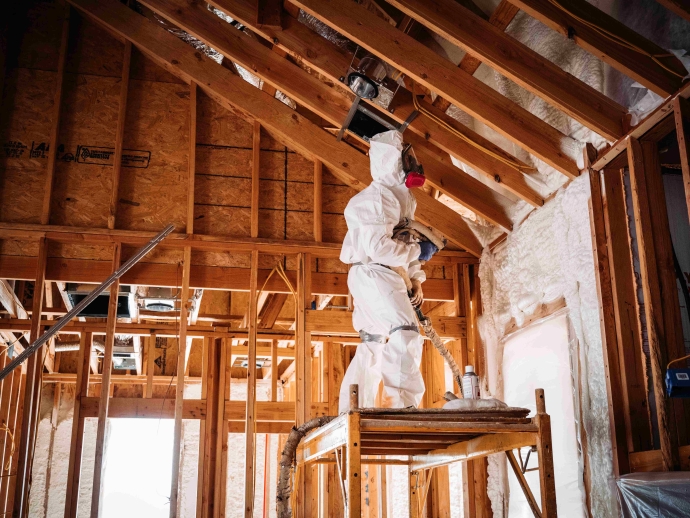How to Combat DFW's Extreme Weather with Spray Foam, Fiberglass, and Cellulose

In the Dallas-Fort Worth (DFW) area, homeowners face unique challenges when it comes to maintaining comfortable indoor temperatures throughout the year. With scorching summers and chilly winters, selecting the right insulation is crucial for energy efficiency, comfort, and cost savings. Among the most popular insulation options are spray foam, fiberglass, and cellulose. Each type has its own set of advantages and disadvantages, making it essential to understand their characteristics to make an informed decision.
Understanding the Insulation Options
Spray Foam Insulation
Spray foam insulation is a modern solution that consists of a mixture of isocyanate and polyol resin. When applied as a liquid, it expands into a foam that fills gaps and creates an airtight seal. There are two types of spray foam:
-
Open-cell spray foam: This type is less dense and provides good sound absorption but has a lower R-value (approximately R-3.5 to R-4 per inch).
-
Closed-cell spray foam: Denser and more rigid, closed-cell foam offers a higher R-value (approximately R-6.5 to R-7 per inch) along with moisture resistance.
Advantages:
-
Excellent air sealing properties
-
High R-value for superior thermal resistance
-
Acts as a moisture barrier, preventing water infiltration
-
Long-lasting durability (up to 80–100 years)
Disadvantages:
-
Higher initial cost (around $1.50 to $3 per square foot for closed-cell)
-
Requires professional installation due to specialized equipment
Fiberglass Insulation
Fiberglass insulation is one of the most traditional insulation materials available. It comes in batts or loose-fill forms and is made from tiny glass fibers. The R-value for fiberglass typically ranges from R-2.9 to R-3.8 per inch, depending on the installation method.
Advantages:
-
Cost-effective option (averaging $0.10 to $0.50 per square foot)
-
Quick and easy installation
-
Non-combustible and resistant to moisture when properly installed
Disadvantages:
-
Lower R-value compared to spray foam
-
Can allow air leaks if not installed correctly
-
May settle over time, reducing effectiveness
Cellulose Insulation
Cellulose insulation is an eco-friendly option made primarily from recycled paper products treated with fire retardants. It is typically installed as loose-fill material and has an R-value ranging from R-3.1 to R-3.8 per inch.
Advantages:
-
Environmentally friendly, made from 100% recycled materials
-
Good sound dampening properties
-
Effective at filling odd-shaped areas due to its loose-fill nature
Disadvantages:
-
Higher initial cost compared to fiberglass
-
Can settle over time, leading to reduced effectiveness
-
Requires professional installation for optimal performance
Factors to Consider When Choosing Insulation
When selecting the right type of insulation for your DFW home, consider several factors:
1. R-Value
The R-value measures thermal resistance; the higher the value, the better the insulation's effectiveness at preventing heat transfer. Spray foam generally provides the highest R-values, making it ideal for energy efficiency in extreme climates.
2. Air Sealing
Spray foam excels in air sealing capabilities due to its ability to expand and fill gaps thoroughly, which helps reduce air leakage significantly. Proper air sealing can prevent conditioned air from escaping your home, leading to lower energy bills.
3. Moisture Resistance
Closed-cell spray foam acts as a moisture barrier, making it ideal for areas prone to humidity or water exposure. In contrast, cellulose can absorb moisture if not treated properly, while fiberglass does not provide effective moisture resistance unless combined with other barriers.
Cost Considerations
While initial costs are important, consider long-term savings on energy bills when evaluating insulation options:
-
Spray Foam: Higher upfront costs but significant energy savings over time due to its superior insulating properties.
-
Fiberglass: The most budget-friendly option initially but may lead to higher energy costs if not installed properly.
-
Cellulose: Moderate initial costs with potential long-term savings due to its effective insulating properties.
Conclusion
Choosing the right insulation for your DFW home is essential for combating extreme weather conditions while maximizing energy efficiency and comfort.
-
If you prioritize energy efficiency and are willing to invest more upfront, spray foam insulation may be the best choice.
-
For those looking for an economical solution with decent performance, fiberglass insulation remains a solid option.
-
If sustainability is your primary concern and you want an eco-friendly material that offers good performance, consider cellulose insulation.
Ultimately, consulting with a professional insulation contractor can provide personalized recommendations based on your specific needs and home characteristics. With the right insulation in place, you can enjoy a comfortable living environment year-round while reducing energy costs in your DFW residence.

